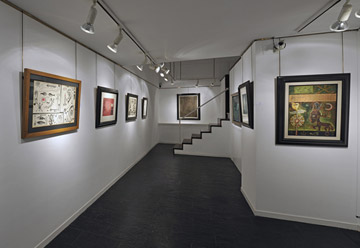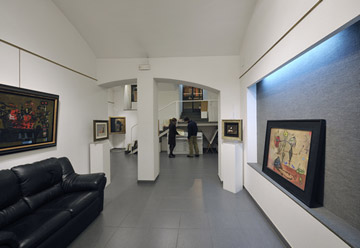- Amat, Frederic
- Amat, Gabriel
- Arranz Bravo
- Arroyo
- Barbara
- Barcelo
- Bartolozzi
- Bea
- Becquer
- Benet
- Bird
- Bores
- Brinkmann
- Brossa
- Cardenas
- Carral
- Casas
- Castillo
- Chancho
- Cisquella
- Clave
- Corneille
- Croft
- Cuixart
- Domingo
- Fabres
- Farreras
- Feito
- Fenosa
- Forteza
- Genovart
- Gimeno
- Gonzalez
- Gonzalo
- Graner
- Granyer
- Grau
- Grau Sala
- Gudiol
- Guinovart
- Hernandez Mompo
- Hernandez Pijuan
- Jorn, Asger
- Junyent, Oleguer
- Lam
- Llena
- Lloveras
- Lopez Ramon
- Marin
- Marsans
- Marsillach
- Marti Alsina
- Matilla
- Meifren
- Menchu Gal
- Meseguer
- Mir
- Mira
- Miro
- Moore
- Moragas
- Munoz
- Noland
- Olive
- Palazuelo
- Palencia
- Pazos
- Perejaume
- Perez Villalta
- Picasso
- Plantalech
- Plasencia
- Plensa
- Ponç
- Puig
- Rafols Casamada
- Ramis
- Rasero
- Rebull
- Riera i Arago
- Rivera
- Roca Sastre
- Roig
- Roig Soler
- Rossell
- Rueda
- Saura
- Serra
- Sicilia
- Solano
- Subirachs
- Sunyer
- Tamayo
- Tapies
- Tharrats
- Togores
- Torres Garcia
- Ubeda
- Ucles
- Valdes
- Valls
- Vedova
- Viladecans
- Vilagrasa
- Villa
- Zao Wou-ki
Artists +
Hours

Ref 1734 Nu
900 €

Ref 2798 Bosc de Can Feu. Sabadell
Price: Inquire
Gimeno
Francesc Gimeno Arasa (Tortosa, 1858 - Barcelona, 1927) was a Catalan painter and draftsman. Known for his reserved character and his distance from the artistic circles of his time, he developed his own realistic style characterized by bold and decisive strokes.
One notable aspect of his artistic production is the extensive collection of self-portraits, approximately around two hundred, which places him in an honorable position in the history of this genre, alongside artists like Rembrandt and Van Gogh. Unlike Rembrandt and Van Gogh, Gimeno’s self-portraits sharply diverge from the rest of his works; they stand out dramatically from other portraits and landscapes, constituting an autonomous and dramatic series. His landscapes and portraits of people from his surroundings are also noteworthy.
Gimeno consistently painted what was within his reach: his family members, the streets he walked (including suburbs), hens, still lifes, his own face, and more. This thematic choice turns his work into a social chronicle of the most disadvantaged layers of Catalonia in the early 20th century. In this regard, Gimeno contrasts with Ramon Casas, who chronicled the Barcelona bourgeoisie.
In 2006, the National Art Museum of Catalonia organized a major exhibition titled "Francesc Gimeno, un artista maldecido" (Francesc Gimeno, a cursed artist).
His works can be found in institutions such as the MNAC, the Montserrat Museum, the Prado Museum in Madrid, among others.




